

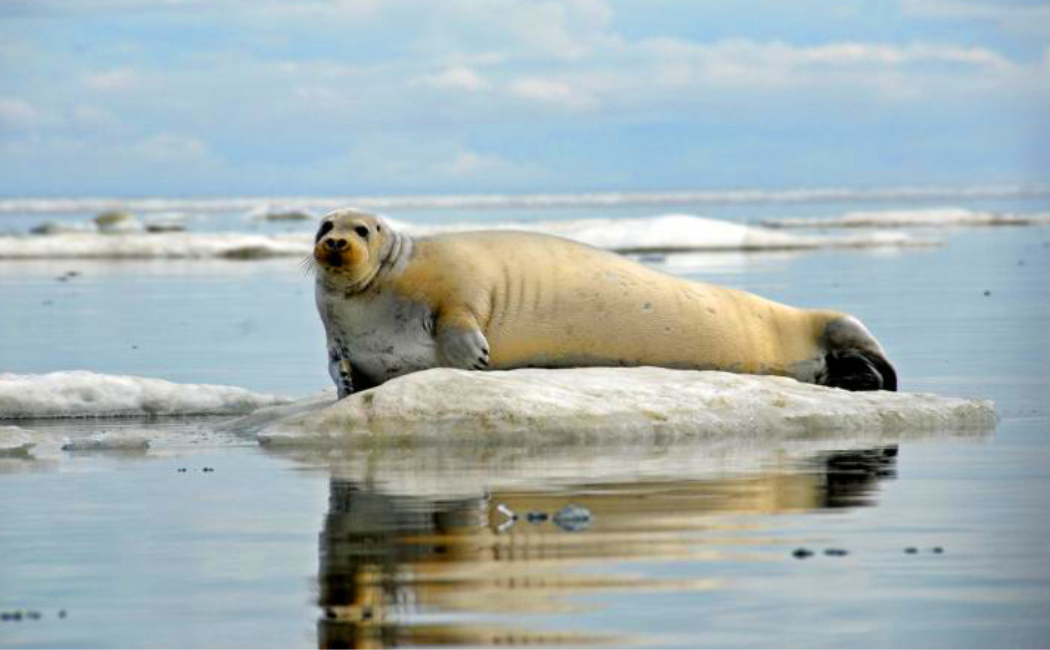
26 May, 2021
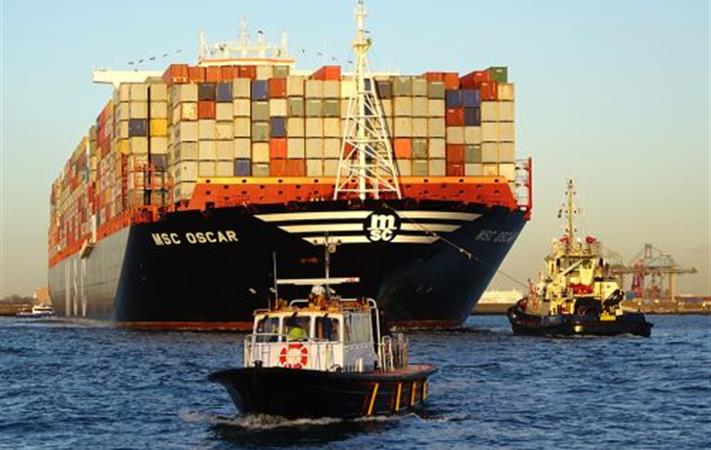
Container ships and fishing boats are among the many sources of human-made sounds contributing to the Anthropocene ocean. Photo credit: Kees Torn / Creative Commons Attribution-ShareAlike 2.0 Generic license
Container ships and fishing boats are among the many sources of human-made sounds contributing to the Anthropocene ocean. Photo credit: Kees Torn / Creative Commons Attribution-ShareAlike 2.0 Generic license
Ocean noise is increasing in prevalence and scale from human sources such as cargo shipping, seismic blasting, active sonar, pile driving and fishing vessels. The extent to which it is changing the character of the ocean soundscape and impacting marine life and their habitats is a largely understudied and unaddressed area.
A multi-institutional meta-study published in Science, in February 2021, The soundscape of the Anthropocene ocean, documents the adverse effects of this sonic footprint, and presents a path toward solutions in a context of ocean health and sustainable ocean economies.
The Anthropocene, a term coined by Nobel Laureate Paul Crutzen, refers to the current period in the history of Earth where human actions and pressures are the dominant influences on most of the processes that govern the functioning of the biosphere.
Dr. Carlos Duarte, lead author and distinguished professor of marine science at KAUST, commented:
"The Anthropocene has been examined from multiple perspectives, but one that has not been addressed is the soundscape of the Anthropocene. This paper is the outcome of a workshop I organized at KAUST in February 2019, after two years of planning and more than five years of thinking about it, that convened colleagues from around the world to address this knowledge gap. Noise propagates much faster and further underwater than it does on land. Evidence indicates that ocean noise interferes with how marine animals hear, communicate, and respond to the ecological processes they depend on for survival."
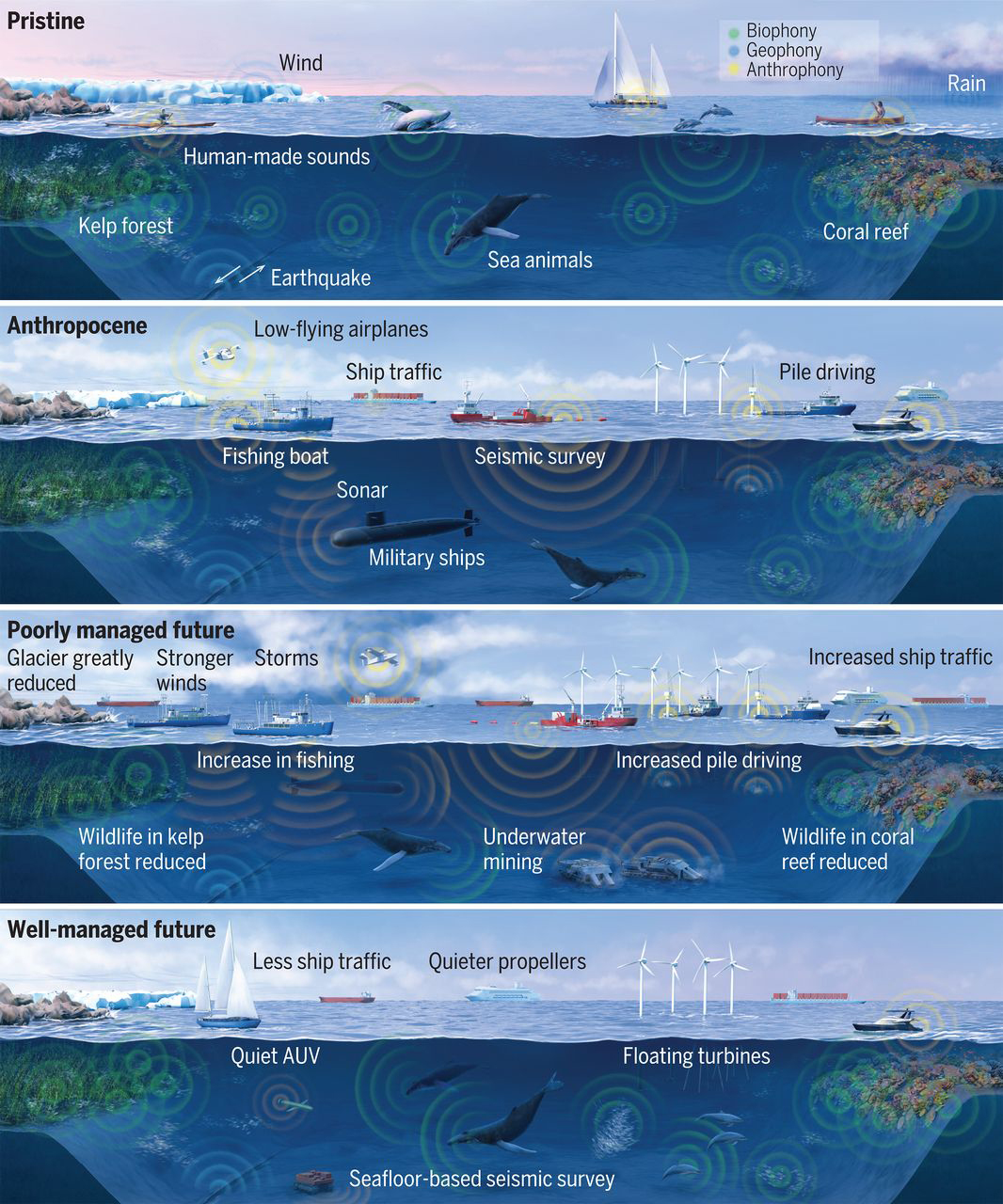
(From top to bottom) Illustration (Figure 1) contrasts pristine oceans soundscapes—largely composed of geophony and biophony sound sources, with minor contributions from human sources—with the present Anthropocene oceans, where human-produced noise and reduced biophony have led to impacts on marine animals. Illustration credit: Xavier Pita / KAUST
The paper draws on expertise spanning multiple disciplines, including neurobiology and the evolution of hearing; marine biology and the role of sound on the behavior of animals; oceanography and how physical properties of the ocean affect acoustics; marine ecology and the impacts of sound on habitats; and big data and machine learning and the classification and decoding of marine sound.The research involved synthesizing and summarizing findings from about 10,000 papers and reviews—a "titanic effort" that Duarte believes will be conducive to policymakers for developing an agenda of action aimed at improving ocean health.

Synthesis of negative impacts of noise pollution on marine animals present in the literature derives from a systematic literature review and comparison of supplementary materials. For detailed caption information, see Figure 4, review summary. Infographic credit: Duarte et al., Science 371, eaba4658 (2021)
A common assumption is that the ocean is silent. This is because humans don't hear very well underwater due to the way our ears function. The paper describes three categories of ocean sound: biophony—the range of biological sounds made by marine organisms, geophony—sounds of the physical environment such as wind and rain, and anthrophony—human-made sounds.
Recordings from instruments like hydrophones reveal that healthy ocean environments are filled with a cacophony of biological sounds, from whale calls to snapping shrimp to crackling ice to croaking fish. Hydrophones also reveal the presence of ocean noise from human activities. Damaged marine environments have much less diversity in the quality of their sounds. The rich sounds of the biophony go away, leaving the geophony and anthrophony.
Marine organisms hear this difference. Marine mammals and fish—even the larvae, juveniles and invertebrates that drift on the ocean currents—can sense, for example, that coral reefs with wide ranging natural sounds are good places to settle. In this way, natural soundscapes serve to guide invertebrates and fish to recruit to healthy coral reefs.
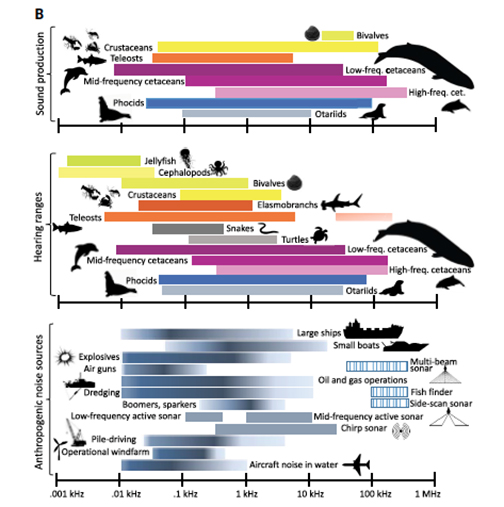
Climate change also has a major impact on the soundscape of reefs and other marine environments. A previous study conducted by co-authors of the study described how the global bleaching event that occurred between 2015 and 2017 led to a four-fold decline in the soundscape of the Great Barrier Reef of Australia, with acoustic levels of marine organisms decreased to 25% of pre-bleaching levels.
Scientists are monitoring the quality of different marine environments by the diversity of sounds found there—biological, geological, and human-made. Each marine environment has its own sonic signature, from the deep waters of Norway to the shallow waters of Belize. The information provides a baseline for them to assess changes over time and potential environmental impacts, with the aim to maintain biodiversity and prevent human-produced sounds from becoming the predominant sounds in the ocean.
Infographic approximates sound production and hearing ranges of marine taxa and frequency ranges of selected anthropogenic sound. For detailed caption information, see Figure 2/B, review summary. Infographic credit: Duarte et al., Science 371, eaba4658 (2021)
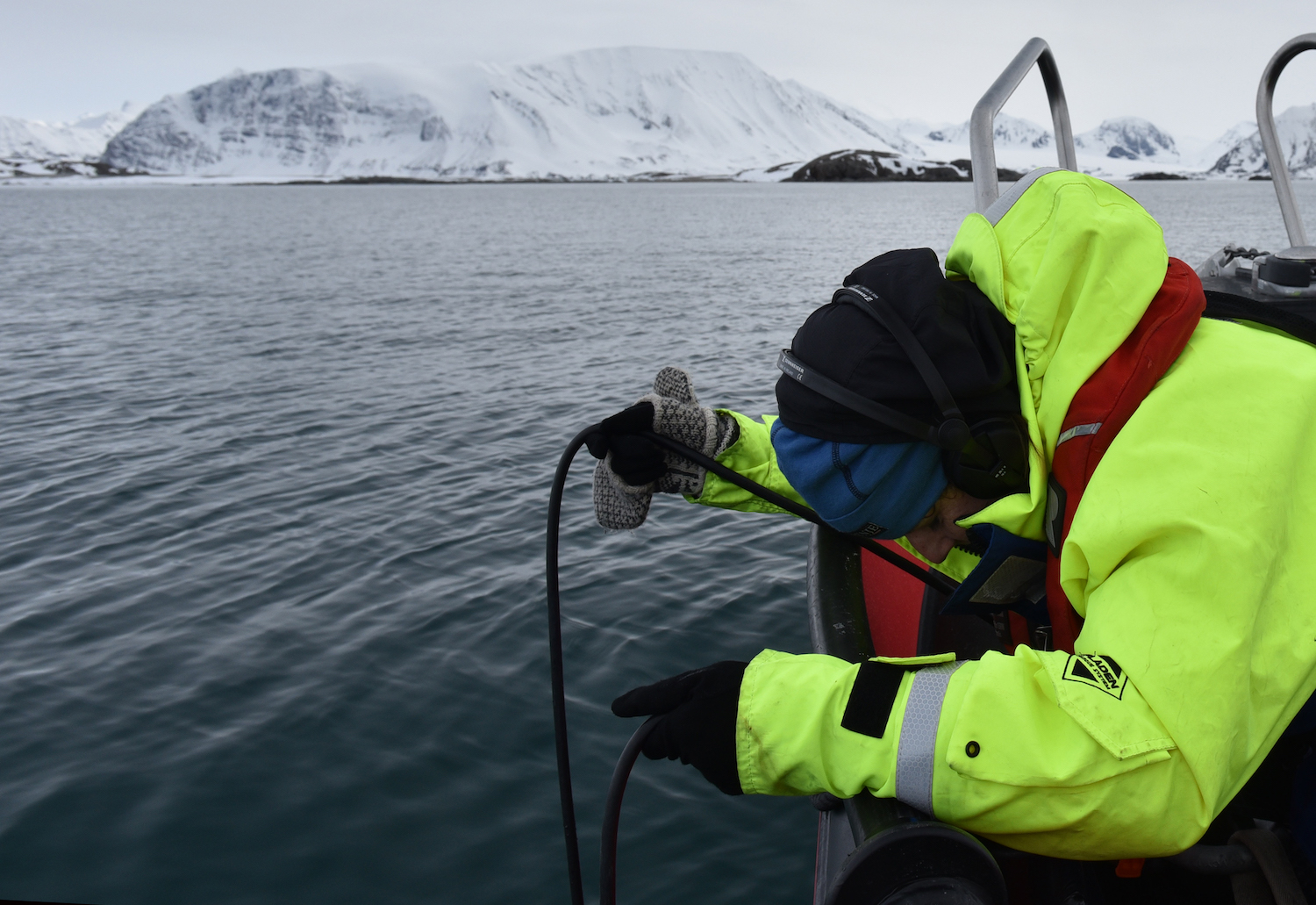
Jana Winderen records bearded seals using a hydrophone in the Barents Sea of the Arctic during an ARCEx marine expedition, 2016. Photo courtesy of Jana Winderen
Sound artist Jana Winderen is motivated to introduce listeners to a range of ocean sounds to raise awareness about the issues that affect marine life, and inspire action to restore their environments.She recalled her first experiences using hydrophones, and how she got hooked in the process:
"An enormously fascinating and inspiring world revealed itself. I started to listen, and every time I went back, I heard a new sound, a new creature—a crustacean or a fish or a mammal echolocating. So all these different things you start to hear and pay attention to."
Winderen and Duarte met on a research ship in the Arctic in 2016, where they were working on a project called Spring Bloom in the Marginal Ice Zone. It was there she first heard and was captivated by the beautiful singing tones of bearded seals. Their calls can be heard among a mix of biological and geological sounds in the composition that she created for the paper, alongside more ominous sounds of the anthrophony from sources such as broadband engines, seal scarer devices and military sonar.
Marine mammals have the broadest, most sensitive hearing, and use sound to find their mates, food, reproduce, echolocate, and avoid predators. For many cetaceans like whales and dolphins whose ears triangulate sound, the noise surrounds and disorients them.
Co-author Dr. Daniel Costa, director of the Institute of Marine Sciences at the University of California in Santa Cruz, brings expertise in the area of marine mammals and evolutionary biology. He said that ocean noise affects marine mammals in a variety of ways. One effect is masking—when sound prevents one from hearing other sounds. Costa likened this to being at a party.
"If somebody at a loud party says something important, like—we've got to get out of the room—you may not hear it, and so you can have missed behaviors," said Costa. "Male humpback whales, for example, use songs to display their capabilities, excite females and compete with other males. Noisy environments mask these songs and other forms of communication and affect their ability to be heard."
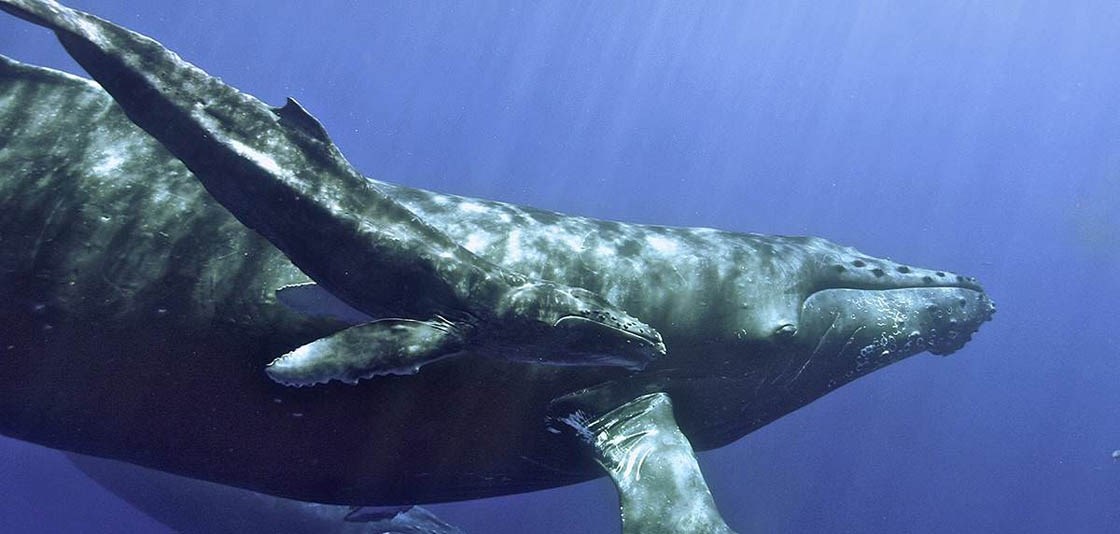
Underwater ocean view of a mother humpback whale with her calf swimming beside her. Photo credit: NOAA
Findings show that right whales are increasing the intensity of their vocalizations to compensate. But not all species can change the frequency of their calls. Dolphins, for example, have fixed, signature whistles, i.e. their "names", that they use to socialize and coordinate activities. It's unknown how these and other species will adapt.Another consequence of shipping noise is that it prevents marine animals from locating prey or avoiding detection by predators. Even small boats are disruptive this way, especially for small fish populations. According to the paper, boat noise is the most common source of noise in the ocean, accounting for a three percent decibel increase in sound levels during the last 50 years.
"We think of small boat engines as having higher frequencies that aren't as loud and don't go very far," said Costa. "But small boats operate in shallow waters, and the effects of that sound can be very pronounced in a localized area. Boat noise changes the ability of the fish recruiting under the coral reefs to hear their predators, and research shows this reduces their populations."
Seismic testing and pile driving are two sources of anthropogenic noise that don't occur as constantly as shipping and boat noise but are much more acute across space and time.
Seismic testing is used to map the density structure of the seafloor, typically for the purpose of finding oil and gas reservoirs. It involves firing canons of compressed air several kilometers below the surface. These blasts are sudden, loud and persistent. Studies show that they affect the hearing threshold of marine animals, temporarily and permanently, dulling hearing or causing ringing in the ears, much in the same way human ears experience tinnitus. The blasts injure marine animals in other ways, and can also kill them.
Pile driving causes similar harm. Its noise comes from hydraulic hammers driving pillars of steel and concrete deep into the ocean floor in order to support bridges, offshore oil platforms, wind farms and other civil engineering installations.
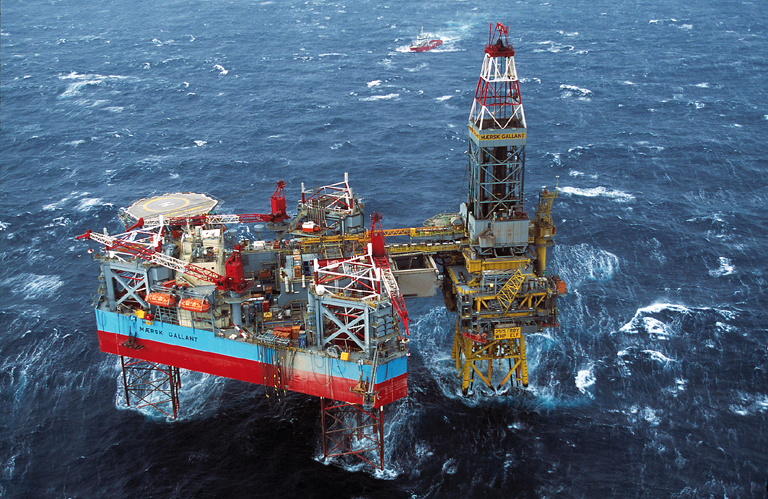
Maersk Gallant, ultra harsh environment jack-up rig, North Sea. Photo credit: Maersk Drilling
Whatever the sound source, chronic exposure to noise induces the stress hormone, cortisol, and cumulatively weakens organisms' persistence and resilience to cope with other stressors in the marine environment. The paper factors the toll that multiple stressors take on marine life. Findings draw on research that evaluates single disturbances, such as sound, in a context of animal responses (feeding, sleeping, migrating, etc.) to other disturbances, such as food availability.Costa explained, "In some cases, noise in and of itself may not be as bad as other stressors, but if food is less available, then it is going to have a more important impact on an animal than in a good year. If we can reduce noise from the list of other stressors impacting marine animals, then that is going to give them a better chance to survive."
The paper extensively documents the impacts of ocean noise. It also highlights solutions, which Duarte said for the most part have been tested, are available, and bring a suite of benefits.
Of the gamut of anthropogenic impacts, he pointed out that noise is one of the easier ones to control. When noise stops, the problem more or less immediately goes away, and ecosystems and organisms can begin to repair. Not so with other kinds of anthropogenic impacts, such as climate change. Even if global actions were to curb CO2 (carbon dioxide) production today, the aggregated effects would last for years, from ocean acidification to fluctuating climate temperatures.
The paper proposed that noise reduction mitigations target 15% of the total number of merchant and fishing vessels, because those 15% contribute more than half of the total ocean noise. Although mitigations won't stop all anthropogenic sounds from occurring, they will reduce them and subsequent impacts.
One strategy is to build vessels with innovative materials that absorb the pressure from interactions with waves and ocean turbulence, and don't make noise. Another is to retrofit vessels with propeller technology designed to reduce noise and vibrations. Duarte cited Maersk, the largest fishing company in the world, for installing noise reduction propellers in five of their largest container vessels. As a result, the company's vessels are quieter, and also more energy efficient—a win-win that lowers transportation costs as well as greenhouse gas emissions and translates to economic savings.
Bubble curtains are being used to buffer noise from activities such as seismic testing and pile driving. In this approach, bubbles released around the area in question form a low frequency curtain that pulls in sound. Initial studies show positive results.
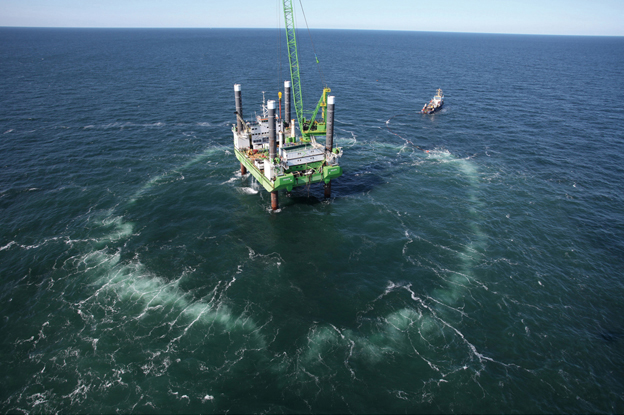
Regulating shipping transit routes to better support marine conservation goals, and creating marine protected areas that restrict boats are examples of legislative strategies that would reduce localized and global impacts of boat and ship noise.
Bubble curtains surround an oil rig to buffer the sound of oil drill activity. Photo credit: Creative Commons Attribution-Share Alike 4.0 International license.
Duarte and co-authors think the timing of the paper is conducive for international discussions and processes that could be translated into healthy ocean policies.
"The European Union (EU) recognizes the ocean soundscape as an integral component of ocean health, and regulates ocean noise and its effect on marine mammals and ecosystems," said Duarte. "Our hope is that the scope of issues and evidence presented in the paper, together with the proposed mitigation actions, will compel other countries to respond."
Duarte serves as a subject expert on the High Level Panel for a Sustainable Ocean Economy, a 14-nation body commissioned by the UN to develop an agenda for sustainable ocean actions—a group that he believes could initiate change.
COP26, an annual conference on climate change, is another important avenue for ocean action. Duarte said the oceans will figure prominently on climate agendas because of increasing awareness about the consequences of climate change on ocean health, including its impact on ocean soundscapes, and the urgent need to develop sustainable strategies for addressing these issues.
KAUST PhD doctoral student and co-author Michelle Havlik, a student of Duarte's, was on the team led by co-author Dr. Harry Harding of Exeter University that collated research for the paper.
She said she was fascinated by soundscapes long before she became a marine biology student, and feels incredibly lucky to be included on a paper that joins these interests.
"This paper opened up the spectrum of interesting research that people around the world are doing on ocean sounds," she said. "If more studies like this could be coordinated worldwide, maybe even on a citizen level, then that would help make these issues more prevalent for people to understand the effects of sounds on animals."
To this end, she said she is excited by the role that passive acoustic monitoring (PAM) in oceans will play in measuring, monitoring, and ultimately revealing information about marine conditions, especially in the deep sea and other hard-to-access areas, and how this knowledge might spur action.
Jana Winderen's recordings and soundscape compositions expand this effort in a way that brings the sounds of the ocean to the public in an accessible way. Winderen said that she builds her compositions to bring attention to the animals communicating, their natural soundscape and also the noise threats in the hope that listeners start to realize why it's important for these creatures to be able to hear each other, their predators, and orient themselves in their home environments.
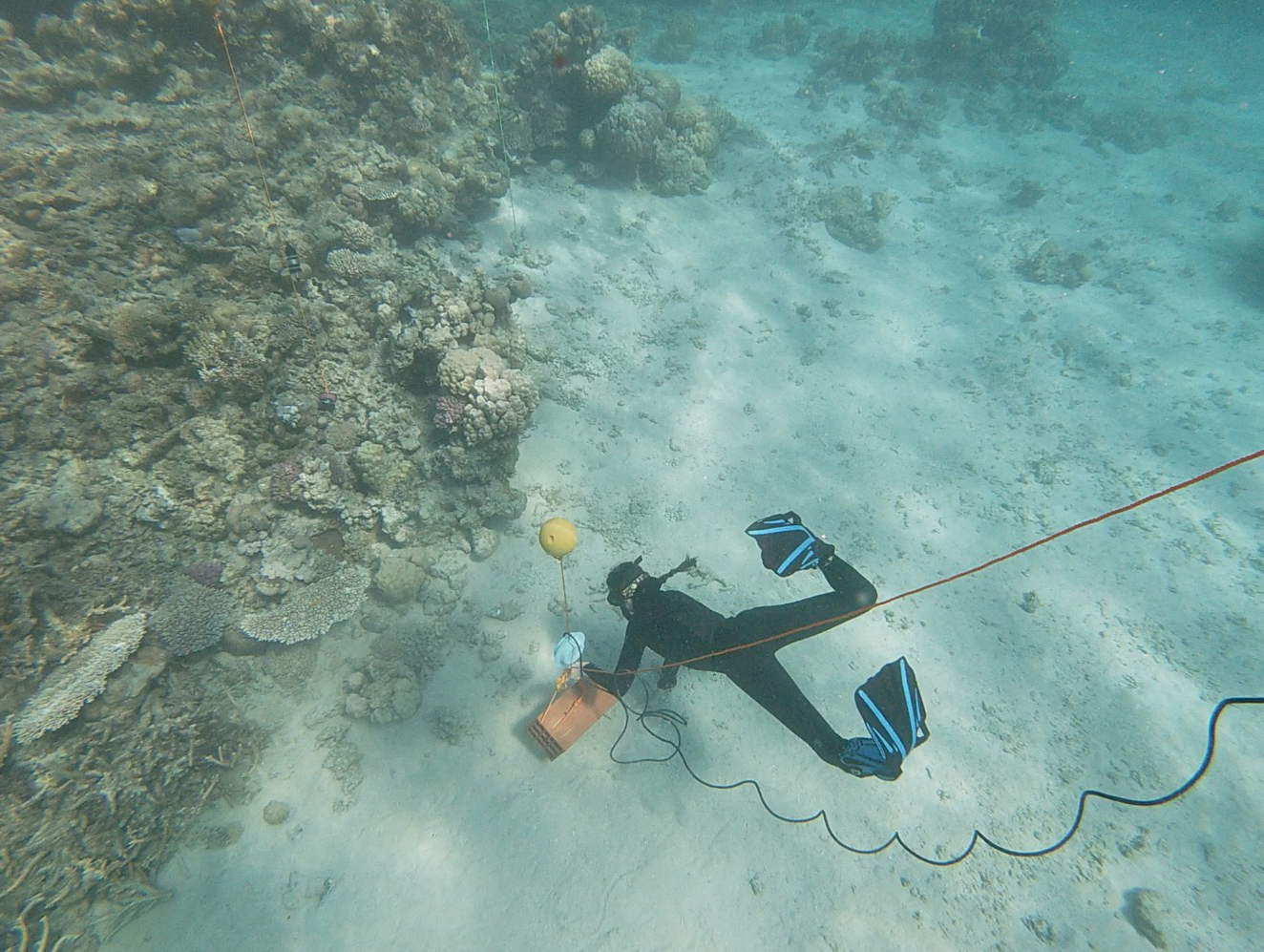
KAUST Ph.D student Michelle Havlik installs a speaker among coral reef in the Red Sea as part of a sound study on clams and conchs. Photo courtesy of Michelle Havlik / KAUST
"The animals need to have the soundscape not totally masked by human-made sounds—these broad-band engine sounds, massive shipping lanes where shipping goes on all the time, or military sonars with their enormous intensity of sound," she said. "For me it's important that people hear as well as read about the issues."Listen to the composition, Spring Bloom in the Marginal Ice Zone (For optimal listening, use headphones.)
Havlik said she's a "total fan girl" of Winderen, and that the recordings she gathers sound otherworldly and alien, reminding her that "we know less about the ocean than we do about space."
"It's really clever the way that she seamlessly mixes in anthropomorphic sounds such as pile driving and deep sea mining over seal trills and other biological sounds," Havlik said. "The noise melts in and takes over in a way that is indicative of how masking in the ocean actually works. Like male whales have these incredible songs that they sing to the females, which are really important and happen every season, but if a boat comes along, then it completely masks these calls."
Havlik, who hopes to study whale cultures and their songs one day, said she thinks these connections will foster more caring, and motivate people to be more inclined toward conservation.
"We're all just one symbiotic organism that relies on the ocean," she reflected. "We're definitely not separate, and I think the more we realize our actions have an effect on the sea, the better off it will be."